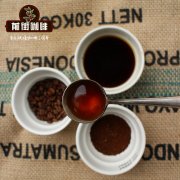The producing area of boutique coffee beans, the best coffee in Ethiopia in Africa, has to mention this wetland.

Professional coffee knowledge exchange more coffee bean information please follow the coffee workshop (Wechat official account cafe_style)
Introduction of Qianjie-Yejia Xuefei producing area
Africa is like everyone's impression that they have higher temperatures and less moisture. So for beans on the African side, most of them are treated in the sun. Because it is directly exposed to the sun in the open space, there may be some sundries, such as grains, small stones, and small worms. The beans processed by it have a relatively high defect rate, but the coffee in Africa has considerable characteristics. The acid is obvious, and then the aroma is also strong.
Yega Xuefei, originally a small town in Sidamo, Ethiopia, is famous for the unique flavor of its coffee and has almost become synonymous with Ethiopian boutique coffee. Ethiopia's geographical environment is very suitable for the growth of coffee, which is mainly grown in the southern highlands between 1100 meters and 2300 meters above sea level. Ethiopian coffee is divided into three major producing areas: Harald, Gima, Sidamo and Yegashifi are from the Sidamo region. Ethiopian coffee is harvested once a year. The beautiful white coffee flowers bloom from March to April, and then the fruit begins to grow. From September to December, the red coffee fruit is ripe for picking. The new season of coffee begins to be exported from November to December.
Here, nearly 2,000 meters above sea level, is one of the highest coffee producing areas in the world. Here, it has been a wetland since ancient times. "Yirga" means "settle down", and "Cheffe" means "wetland". Lake Turkana, Lake Abaya and Lake Chamo bring rich water vapor here. The mode of production and flavor of coffee here is so outstanding that Ethiopian coffee farmers compete to be proud of the flavor of their coffee, making it the most famous coffee producing area in Africa. The Rift Valley, represented by Misty valley, is foggy all the year round, like spring all the year round, with a gentle breeze, cool and humid, and thousands of coffee trees thrive, giving birth to the unique and unpredictable atmosphere of Yejia Xuefei's unique fragrance of flowers and fruits.
European monastic academics opened up a local coffee growing industry, which was later run by coffee communities or cooperatives in villages around the town. There are no special plantations here, and coffee trees are naturally scattered in forests and countryside, mixed with other crops. During the harvest season, the Ethiopian Coffee Trading Company will go to town to buy coffee beans collected by farmers and eventually sell them under the brand name "Yega Xuefei".
Grading:
Water washing Yega Xuefei is classified as Grade 1 and Grade 2.
Sun Yega Chuefei is graded as Grade 1, Grade 3, Grade4, Grade 5. (in fact, to ensure quality, there are almost no Yega Chuefei beans below Grade 3 for sale. )
Ethiopia's grading system is not based on the number of items, but on the percentage of defective beans in all raw beans. Grade 1 is the highest grade, that is, the lowest defect rate, the best quality Yega Xuefei, the price is also the highest.
Knowledge: Yega Xuefei made his fortune in 1959 when farmers abandoned the traditional method of tanning and switched to water washing, which is more common in South America, to improve quality and reduce defect rates.
In short: Qianjie is a coffee research hall, happy to share the knowledge about coffee with you, we share unreservedly just to make more friends fall in love with coffee, and there will be three low-discount coffee activities every month. The reason is that Qianjie wants to make more friends drink the best coffee at the lowest price, which has been Qianjie's tenet for 6 years!
END
Important Notice :
前街咖啡 FrontStreet Coffee has moved to new addredd:
FrontStreet Coffee Address: 315,Donghua East Road,GuangZhou
Tel:020 38364473
- Prev

What is the grade of Rosa Coffee? it is necessary to know the brand of Panamanian Rosa Coffee.
Professional coffee knowledge exchange more coffee bean information please follow the coffee workshop (Wechat official account cafe_style) front street-Emerald Manor Rose Summer introduction until the Panamanian Emerald Manor (Panama La Esmeralda) owner DanielPeterson, accidentally found in the top of their coffee estate, these were originally used as a windbreak geisha coffee trees produced coffee beans
- Next

Which is the first coffee producing area in Brazil? which is the first coffee producing area in the world?
Professional coffee knowledge exchange more coffee bean information please follow the coffee workshop (Wechat official account cafe_style) front street-Brazil coffee producing area introduces Brazil is the world's largest coffee producing country, the total output of the world's first, accounting for about 1 stroke 3 of the total global production, mainly produced in the central and southern provinces. Brazil is suitable for growing coffee, the terrain is relatively flat, and most coffee gardens are 12% above sea level.
Related
- Beginners will see the "Coffee pull flower" guide!
- What is the difference between ice blog purified milk and ordinary milk coffee?
- Why is the Philippines the largest producer of crops in Liberia?
- For coffee extraction, should the fine powder be retained?
- How does extracted espresso fill pressed powder? How much strength does it take to press the powder?
- How to make jasmine cold extract coffee? Is the jasmine + latte good?
- Will this little toy really make the coffee taste better? How does Lily Drip affect coffee extraction?
- Will the action of slapping the filter cup also affect coffee extraction?
- What's the difference between powder-to-water ratio and powder-to-liquid ratio?
- What is the Ethiopian local species? What does it have to do with Heirloom native species?

